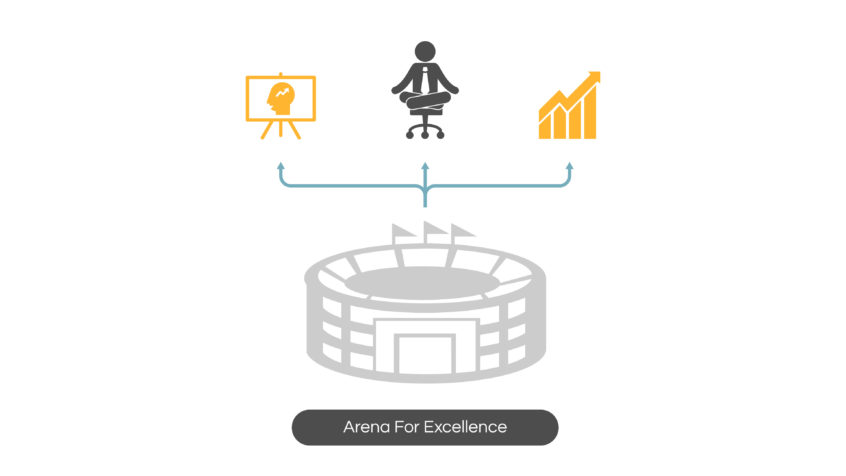Are your competencies destroying performance?
Procurement Competency Modeling Removes Organizational Inertia. We have always done it this way and see no need to change – we have all seen it, but CPP can help prevent it in your organization with Procurement Competency Modeling
1. Procurement Competency Modeling: Outdated competencies breed organizational inertia
Procurement Competency Modeling is an initiative designed to align the skills, knowledge, and abilities of the procurement team with the company’s strategic goals and objectives. The term competence refers to:
an ability, skill, or attribute associated with superior job performance.
Procurement Competency models are commonly used as the basis for benchmarking, training, development, and human resource management, their stated purpose is to:
- define the skills, knowledge, and attributes for success
- hire people who have those qualities
- develop people, so they do, often replacing or reassigning those who rate lowest on the defined competencies.
The logic is that once everyone, is hired, developed, and trained to possess key competencies, procurements performance and ultimately the businesses bottom line will improve. But:
how do we know which competencies for individual success are both necessary and sufficient for improving business success and the bottom line?
What is often missing is a concrete and verifiable link between the individual accomplishments and the achievement of organizational goals.
2. Success comes from competence
We define Competence as the achievement of results that contribute to business goals.
A competence model, therefore, is an organized framework that identifies the set of accomplishments procurement professionals must produce to fulfill their job’s purpose and the business goals associated with it, plus the critical behavior needed to produce those accomplishments.
Competence is not measured by attainment of skills and professional accreditation, or by a test, or by a self-assessment or rating scale. Instead, competence is measured by the accomplishment of results that contribute to organizational success.
3. Problems with many Procurement Competency Models
Competencies are often expressed as behaviors. But combinations of skillful behavior around a set of competencies might occur without generating any valuable accomplishments. For example:
if the business goal is total cost reduction, Category Managers, might be able to demonstrate different types of behavior learned in procurement training, such as demand and market analysis, yet fail to produce desired category outcomes.
Alternatively, if we specify business results (e.g., TCO reduction) and key accomplishments required to produce them (e.g., standardize specifications, supplier selection), we create a much clearer path for trainers, managers, and category managers themselves to contribute to the bottom line.
There are dozens of behaviors and competencies required for the achievement of key accomplishments that, by themselves, will never lead to the desired business result of lower TCO. By clarifying desired accomplishments, however, it is possible to put together the right combinations of behavior to produce results.
3.1 Our Approach starts with the end in mind.
- Start with the business results the business wants to achieve
- Work backward to understand what accomplishments, will achieve these goals
- We can then define the criteria for a successful outcome and
- Map the steps to be taken that should lead to the achievement of the targeted outcome.
- CPP Strategic-Assessment Process
With this information, it is straightforward to identify the right behaviors that will produce the outcomes necessary to achieve the businesses desired results.
4. Components of the CPP Competence Model
We use three phases to develop your competency system:
4.1 Inputs:
Figure 2 shows the CPP process for building your organization’s unique competence model, including inputs, outputs, and applications. We describe this process below:
a) Business Goals & Objectives:
Describe what the business wants to accomplish in financial, customer, internal, and growth terms. The strategy is how the management of the organization plans to accomplish its goals.
b) Roles & Job Descriptions:
Mission: Describes the purpose of a specific role—the ultimate product or service that results from this role and how this product or service contributes to the goals of the organization. In defining the mission of the role, answer the following questions:
- Why does the job exist?
- How does it help achieve organizational goals?
Key Accomplishments: Reflect job performance, including:
- work processes followed;
- major accomplishments against targeted outcomes that are necessary to achieve the job mission;
Brought to life by defining the criteria for success and milestones to be achieved on the road to success:
Criteria for success: Answers the question – “how do we know we have been successful?”
Milestones: Breaks down the accomplishment into a series of steps that must be completed in order to achieve the goal accomplishment.
In this way, success becomes self-monitoring for the job holder.
c) Competencies
From the defined accomplishments a role must achieve to be successful we can identify the competencies that must be carried out. These are the related tasks, behaviors, or competencies that link together to build the accomplishments. For example, for a Category Manager needs to:
- Identify and define the business and stakeholder needs
- Evaluate supply markets
- Develop sourcing strategies
- Select the best suppliers
- Manage contracts and suppliers
- Under each accomplishment, there might be sub-accomplishments.
4.2 Outputs
a) Capability Value Chain
The information gained during the input stage is captured and transformed to produce the value adding knowledge, behaviours, and accomplishments that will support and contribute to achievement of business goals.
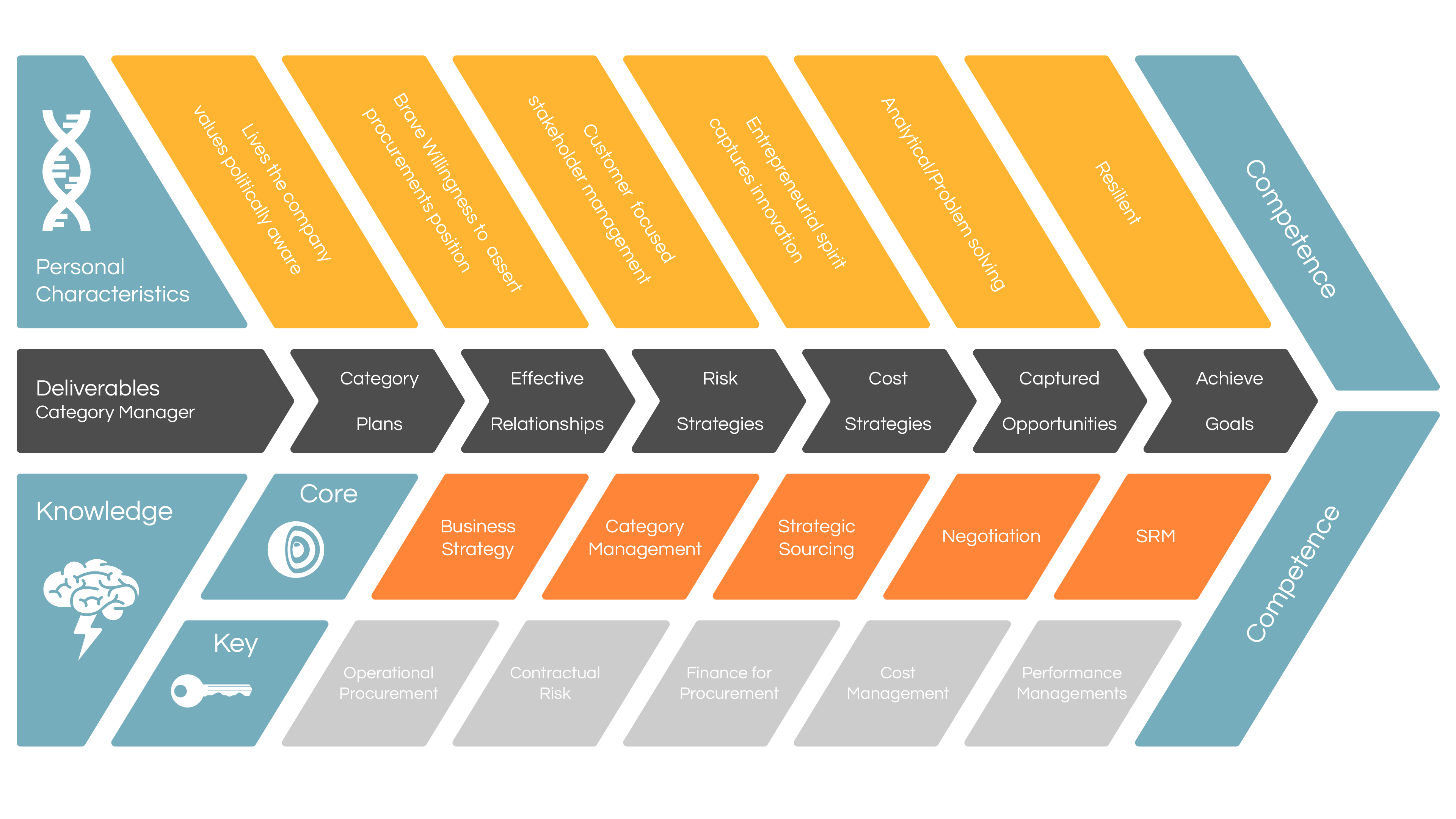
CPP-Role-Value-Chain
We present this as a value chain which must also be considered within the context the capability framework will operate in.
b) Contextual Factors
An analysis of the environment and individual factors that enable or prevent competence. These come together in our Capability Chain, which links the operating environment and the individual together:
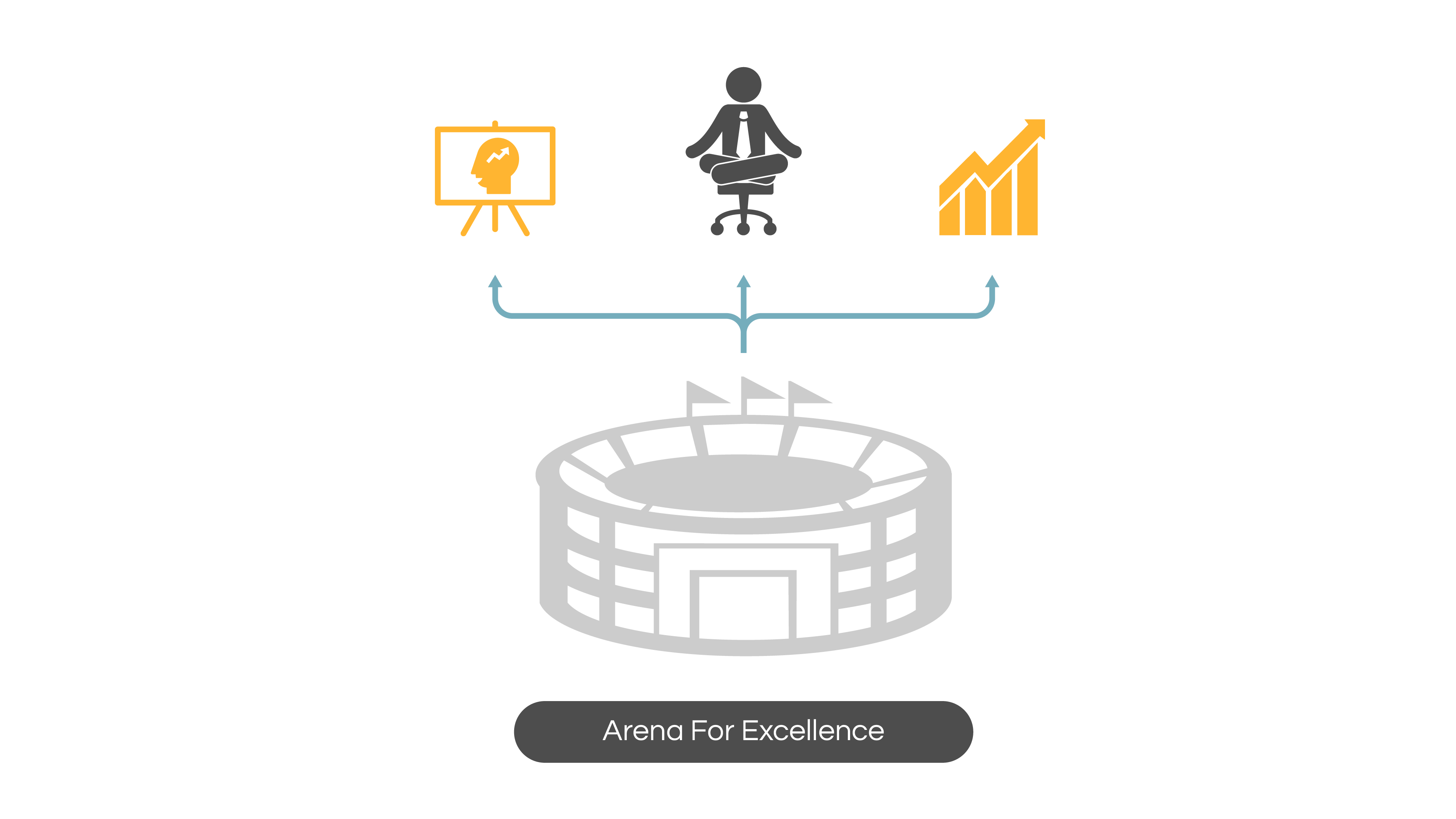
Environment context is critical to success
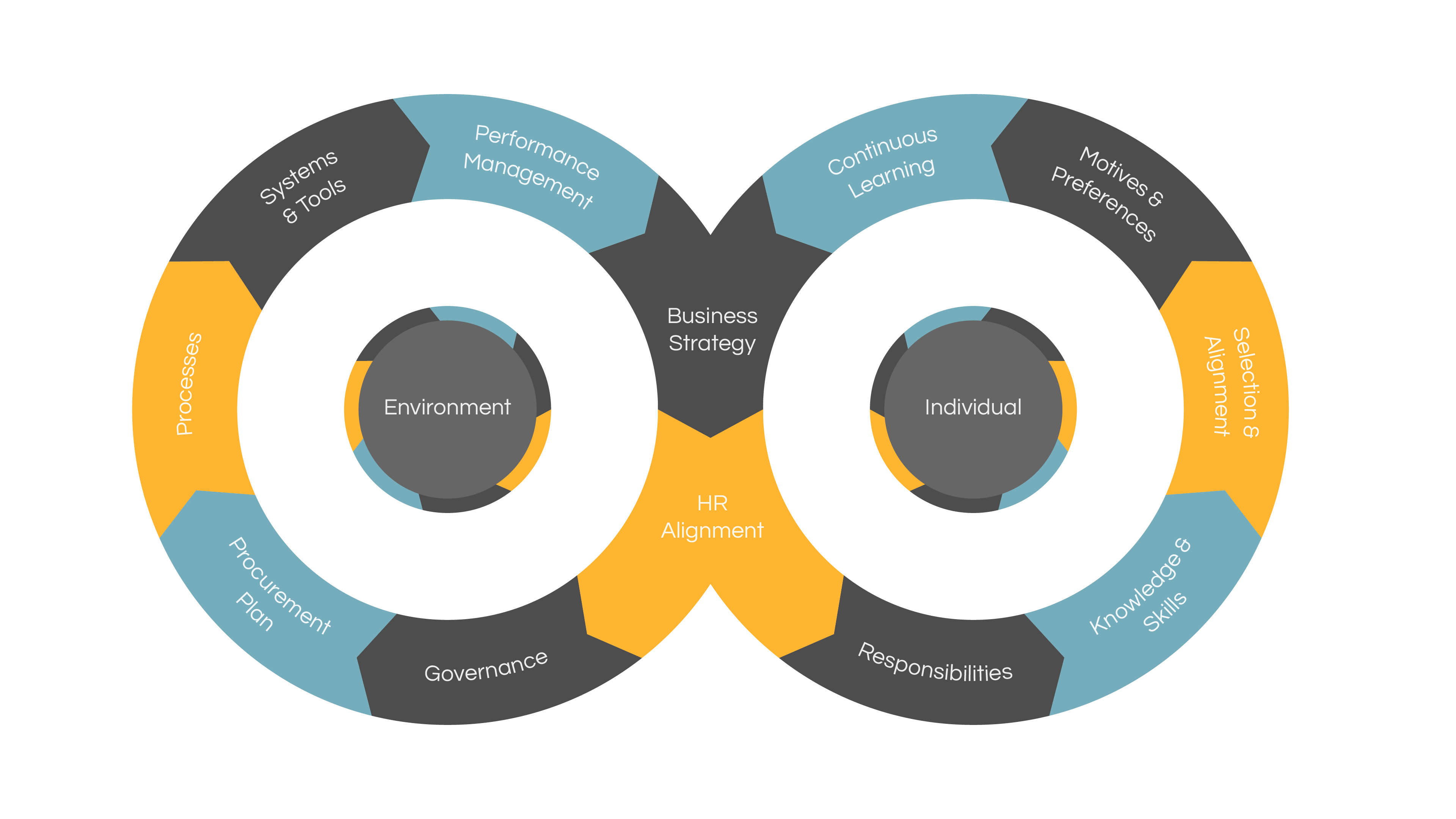
CPP-Arena-of-Excellence
The system recognizes that a competent individual may be ineffective in a poorly governed environment. We use this model to conduct a contextual analysis, reviewing the factors required to build, support, and maintain the desired competence levels and uncovering the obstacles that prevent desired levels of competence.
c) Competency Framework
With this information in place, a competency framework is produced. A set of defined competencies that provide a structured means to measure individual and organization wide capabilities.
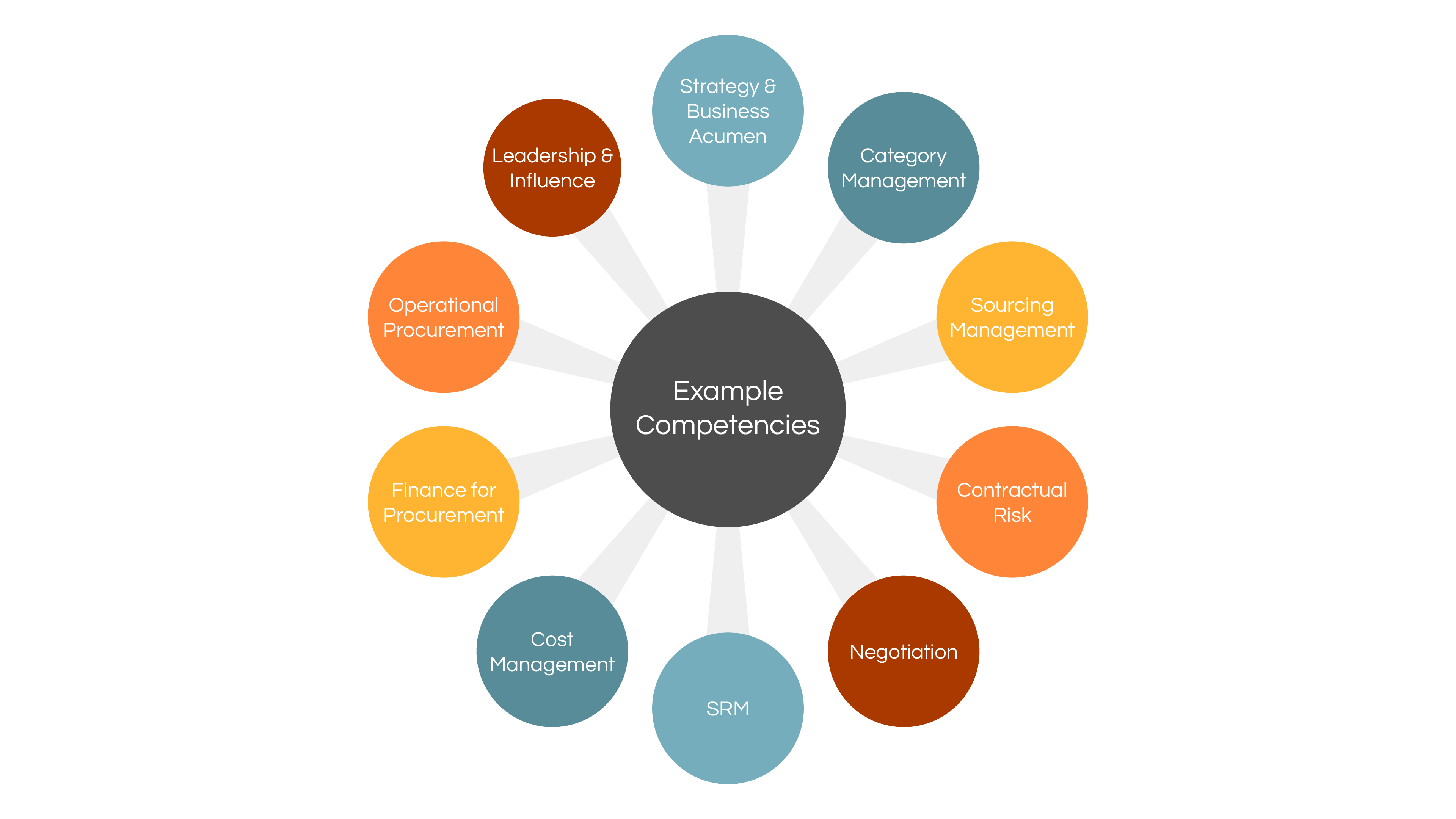
CPP Competency Framework Example
Such a framework supports decisions from who to hire, to whom to promote, to where to develop, and plan succession by making informed talent decisions which is embedded in our iProcure Platform which provides the skills assessment tool to enhance organization wide procurement capability.
5. Applications and Value
The CPP Competence Models supports organizations in aligning and linking individual accomplishments to organizational goals. If the competence model does not link to the organizational system, then its value will be diluted.
An organizational system is all the functions within an organization that input to procurement goals and contribute to the achievement of the organization’s goals and employees’ competence. To fully leverage the value of the competence model, the organizational systems can be used to do the following:
- Design job profiles and performance assessments to gauge the competence levels of candidates before you hire them.
- Communicate what success looks like in specific, and measurable terms.
- Provide assessment tests to assure the business that certified employees really can fulfil their role competently. Not just that they have the required knowledge and skills.
- Gap Analysis & Training Curriculum: Provide training based on known gaps in competence and opportunities for building competence.
- Provides company-wide aggregated reporting so you can make collective knowledge visible to those that need to plan succession, make development plans, and engage employees to provide feedback, coaching, performance reviews and collaboration opportunities.
6. Procurement Competency Modeling
Summary
A capability model is a system level framework that enables CPO’s to see the big picture, clear the mist and see the wood for the trees.
By managing at the system level rather than at the component level, the system can be fine-tuned so that each component is optimized to sustain a successful system. By describing the components of system performance:
- starting with business results
- working backward through accomplishments,
- sub-accomplishments, and
- behavior
We explicitly link the behavior of individuals to organizational goals and results. Consequently, we take ambiguity, and subjectivity out of performance development and management, to bring clarity of expectations and more focused performance interventions.
While creating an effective competency model may involve more in terms of time, effort and cost to start with, the return on investment is substantial and long lasting.
When we take the time to define clear, consistent expectations, we tend to get more of what we want—more consistently and at a lower cost. Our iProcure Platform can help.
Nuff said …
Contact us to learn more about our Competency Profiling services.
Learn more about Procurement Competency Profiling
and here Procurement Competency Frameworks

